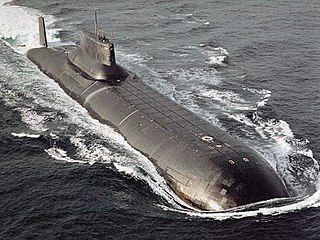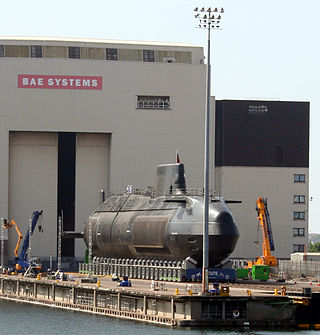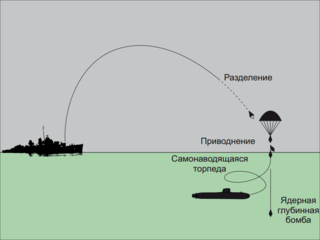
A submarine-launched ballistic missile (SLBM) is a ballistic missile capable of being launched from submarines. Modern variants usually deliver multiple independently targetable reentry vehicles (MIRVs), each of which carries a nuclear warhead and allows a single launched missile to strike several targets. Submarine-launched ballistic missiles operate in a different way from submarine-launched cruise missiles.
A ballistic missile submarine is a submarine capable of deploying submarine-launched ballistic missiles (SLBMs) with nuclear warheads. These submarines became a major weapon system in the Cold War because of their nuclear deterrence capability. They can fire missiles thousands of kilometers from their targets, and acoustic quieting makes them difficult to detect, thus making them a survivable deterrent in the event of a first strike and a key element of the mutual assured destruction policy of nuclear deterrence.

An attack submarine or hunter-killer submarine is a submarine specifically designed for the purpose of attacking and sinking other submarines, surface combatants and merchant vessels. In the Soviet and Russian navies they were and are called "multi-purpose submarines". They are also used to protect friendly surface combatants and missile submarines. Some attack subs are also armed with cruise missiles, increasing the scope of their potential missions to include land targets.

The Yankee class, Soviet designations Project 667A Navaga (navaga) and Project 667AU Nalim (burbot) for the basic Yankee-I, were a family of nuclear-powered ballistic missile submarines built in the Soviet Union for the Soviet Navy. In total, 34 units were built: 24 in Severodvinsk for the Northern Fleet and the remaining 10 in Komsomolsk-on-Amur for the Pacific Fleet. Two Northern Fleet units were later transferred to the Pacific.

A cruise missile submarine is a submarine that carries and launches cruise missiles as its primary armament. Missiles greatly enhance a warship's ability to attack surface combatants and strike land targets; although torpedoes are a more discrete option for submerged submarines, missiles give a much longer stand-off range, shorter time to impact the target, as well as the ability to engage multiple targets on different headings at the same time. Many cruise missile submarines retain the capability to deploy nuclear warheads on their missiles, but they are considered distinct from ballistic missile submarines due to the substantial differences between the two weapons systems' flight characteristics; cruise missiles fly aerodynamically using flight surfaces like wings or fins, while a ballistic missile uses its engine power alone as it may exit the atmosphere.

The Typhoon class, Soviet designation Project 941 Akula, was a class of nuclear-powered ballistic missile submarines designed and built by the Soviet Union for the Soviet Navy. With a submerged displacement of 48,000 tonnes, the Typhoons were the largest submarines ever built, able to accommodate comfortable living facilities for the crew of 160 when submerged for several months. The source of the NATO reporting name remains unclear, although it is often claimed to be related to the use of the word "typhoon" ("тайфун") by General Secretary Leonid Brezhnev of the Communist Party in a 1974 speech while describing a new type of nuclear ballistic missile submarine, as a reaction to the United States Navy's new Ohio-class submarine.

The Victor class, Soviet designations Project 671 Yorsh, Project 671RT Syomga and Project 671RTM/RTMK Shchuka,, are series of nuclear-powered attack submarines built in the Soviet Union and operated by the Soviet Navy. Since the 1960s, 48 units were built in total, of which the last remaining are currently in service with the Russian Navy. The Victor-class submarines featured a teardrop shape, allowing them to travel at high speed. These vessels were primarily designed to protect Soviet surface fleets and to attack American ballistic missile submarines. Project 671 began in 1959 with the design task assigned to SKB-143.

A nuclear submarine is a submarine powered by a nuclear reactor, but not necessarily nuclear-armed. Nuclear submarines have considerable performance advantages over "conventional" submarines. Nuclear propulsion, being completely independent of air, frees the submarine from the need to surface frequently, as is necessary for conventional submarines. The large amount of power generated by a nuclear reactor allows nuclear submarines to operate at high speed for long periods, and the long interval between refuelings grants a range virtually unlimited, making the only limits on voyage times being imposed by such factors as the need to restock food or other consumables.

The Akula class, Soviet designation Project 971 Shchuka-B is a series of fourth generation nuclear-powered attack submarines (SSNs) first deployed by the Soviet Navy in 1986. There are four sub-classes or flights of Shchuka-B, consisting of the original seven Project 971 boats, commissioned between 1984 and 1990; six Project 971Is, commissioned between 1991 and 2009; one Project 971U, commissioned in 1995; and one Project 971M, commissioned in 2001. The Russians call all of the submarines Shchuka-B, regardless of modifications.

The RPK-2 Vyuga, also designated as 81R, is a Soviet submarine-launched, nuclear-armed anti-submarine missile system, launched exclusively through 533-millimetre (21.0 in) torpedo tubes. The system was designed in Sverdlovsk, Russian SFSR in the 1960s.

A submarine-launched cruise missile (SLCM) is a cruise missile that is launched from a submarine. Current versions are typically standoff weapons known as land-attack cruise missiles (LACMs), which are used to attack predetermined land targets with conventional or nuclear payloads. Anti-ship cruise missiles (ASCMs) are also used, and some submarine-launched cruise missiles have variants for both functions.

Project 629, also known by the NATO reporting name Golf, was a class of diesel-electric ballistic missile submarines that served in the Soviet Navy. All boats of this class had left Soviet service by 1990, and have since been disposed of. According to some sources, at least one Golf-class submarine was operated by China, to test new submarine-launched ballistic missiles (SLBMs).

The Delta class, Soviet designations Project 667B Murena, Project 667BD Murena-M, Project 667BDR Kalmar, Project 667BDRM Delfin, are a family of nuclear-powered ballistic missile submarines, designed and built in the Soviet Union, which formed the backbone of the Soviet and Russian strategic submarine fleet since their introduction in 1973. They carry nuclear ballistic missiles of the R-29 Vysota family, with the Delta I, Delta II, Delta III and Delta IV classes carrying the R-29/SS-N-8 'Sawfly', R-29D/SS-N-8 'Sawfly', R-29R/SS-N-18 'Stingray' and R-29RM/SS-N-23 'Skiff' respectively.

Rubin Central Design Bureau for Marine Engineering in Saint Petersburg is the largest of Russia's three main centers of submarine design, the other two being Malakhit Marine Engineering Bureau and Lazurit Central Design Bureau. Rubin has designed more than two-thirds of the nuclear submarines in the Russian Navy. "Rubin" is the Russian word for ruby.

The Borei class, alternate transliteration Borey, Russian designation Project 955 Borei and Project 955A Borei-A, are a series of nuclear-powered ballistic missile submarines being constructed by Sevmash for the Russian Navy. The class has been replacing the steadily retiring Russian Navy Delta III and Delta IV classes and fully retired Typhoon, all three classes being Soviet-era submarines.

Dmitriy Donskoy is a decommissioned Russian Navy nuclear ballistic missile submarine, designated Project 941 Akula class.

K-551 Vladimir Monomakh is a Russian ballistic missile submarine of the fourth generation Borei class that became operational in 2015. It is named after Vladimir II Monomakh (1053–1125), the Grand Duke of Kievan Rus'.

The People's Liberation Army Navy Submarine Force (PLANSF) is the submarine service of the People's Liberation Army Navy. It consists of all types of submarines in operational service organized into three fleets: the North Sea Fleet, the East Sea Fleet, and the South Sea Fleet. Submarines have long been one of the three focuses of the People's Liberation Army Navy, and when the decision was made in late 2006 to concentrate on building other principal surface combatants to strengthen the air defense and to further delay the construction of aircraft carriers due to insufficient air cover, submarines will continue to play the lead dominant role in the assault force for the PLAN. Currently, PLANSF operates a fleet of 66 submarines which include nuclear as well as conventional submarines.

JSC PO Sevmash is a Russian joint-stock company (JSC) under the vertically-integrated United Shipbuilding Corporation. The shipbuilding operations of Sevmash is in the port city of Severodvinsk on the White Sea in the Russian Federation.

K-211 Petropavlovsk-Kamchatskiy is a Project 667BDR Kalmar class Russian nuclear ballistic missile submarine. The submarine was built by Sevmash, Severodvinsk in the late 1970s and joined the Soviet fleet in 1980. The submarine continued to serve in the Russian Navy as part of the Pacific Fleet after the collapse of the Soviet Union. She was decommissioned in 2010 and is currently laid up, awaiting disposal. Her role and those of the other boats of her class is being taken by the new Borei-class submarines.